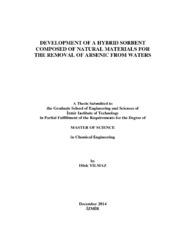Please use this identifier to cite or link to this item:
https://hdl.handle.net/11147/4278Full metadata record
| DC Field | Value | Language |
|---|---|---|
| dc.contributor.advisor | Sofuoğlu, Sait Cemil | en_US |
| dc.contributor.author | Yılmaz, Dilek | - |
| dc.date.accessioned | 2015-05-07T13:43:33Z | |
| dc.date.available | 2015-05-07T13:43:33Z | |
| dc.date.issued | 2014 | |
| dc.identifier.uri | http://hdl.handle.net/11147/4278 | |
| dc.description | Thesis (Master)--Izmir Institute of Technology, Chemical Engineering, Izmir, 2014 | en_US |
| dc.description | Includes bibliographical references (leaves: 47-52) | en_US |
| dc.description | Text in English; Abstract: Turkish and English | en_US |
| dc.description | x, 52 leaves | en_US |
| dc.description.abstract | A novel sorbent has been developed by immobilizing chitosan onto pumice for As(V) sorption from waters. In order to ensure its functionality, sorption performance was determined by measuring As concentrations in water using hydride generation atomic absorption spectrometry. The success of the immobilization was checked with characterization techniques as scanning electron microscopy, thermal gravimetric analysis, and elemental analysis. Points of zero charges were determined with potentiometric mass titration. Batch type equilibration studies showed that the sorbent can be employed at a wide pH range resulting in quantitative sorption (>90%) at pH 3.0-7.0, and greater than 70% sorption at pH>8.0. These results demonstrate the advantage of immobilizing chitosan onto pumice, because, under the same conditions, pumice displays <20% sorption towards As(V) whereas chitosan gives approximately 90% sorption but only at pH 3.0. The validity of the method was verified through the analysis of ultra-pure, bottled drinking, and tap water samples spiked with arsenate; the respective sorption percentages of 93.2 (±0.7), 89.0 (±1.0), and 80.9 (±1.3) were obtained by batch type equilibration. The sorbent was applied in a column for the spiked samples of ultra-pure and tap water. Similar sorption percentages (60% at the 18th fraction) were obtained for ultra-pure water whereas the methodology gave more efficient results for tap water (90% at the 20th fraction) demonstrating the potential of the sorbent for an efficient water treatment system. Arsenic sorption was also examined in the presence of common interfering ions resulting in competing effects of PO43- and NO3- on As(V) adsorption. | en_US |
| dc.language.iso | en | en_US |
| dc.publisher | Izmir Institute of Technology | en_US |
| dc.rights | info:eu-repo/semantics/openAccess | en_US |
| dc.subject | Arsenic | en_US |
| dc.subject | Chitosan | en_US |
| dc.subject | Pumice | en_US |
| dc.subject | Removal | en_US |
| dc.subject | Biosorbent | en_US |
| dc.title | Development of a hybrid sorbent composed of natural materials for the removal of arsenic from waters | en_US |
| dc.title.alternative | Sulardan arsenik giderimi için doğal malzemelerden yapılmış bir hibrit sorbent geliştirilmesi | en_US |
| dc.type | Master Thesis | en_US |
| dc.institutionauthor | Yılmaz, Dilek | - |
| dc.department | Thesis (Master)--İzmir Institute of Technology, Chemical Engineering | en_US |
| dc.relation.publicationcategory | Tez | en_US |
| item.languageiso639-1 | en | - |
| item.fulltext | With Fulltext | - |
| item.openairecristype | http://purl.org/coar/resource_type/c_18cf | - |
| item.openairetype | Master Thesis | - |
| item.grantfulltext | open | - |
| item.cerifentitytype | Publications | - |
| Appears in Collections: | Master Degree / Yüksek Lisans Tezleri | |
Files in This Item:
| File | Description | Size | Format | |
|---|---|---|---|---|
| T001301.pdf | MasterThesis | 1.12 MB | Adobe PDF |  View/Open |
CORE Recommender
Page view(s)
102
checked on Jul 22, 2024
Download(s)
56
checked on Jul 22, 2024
Google ScholarTM
Check
Items in GCRIS Repository are protected by copyright, with all rights reserved, unless otherwise indicated.